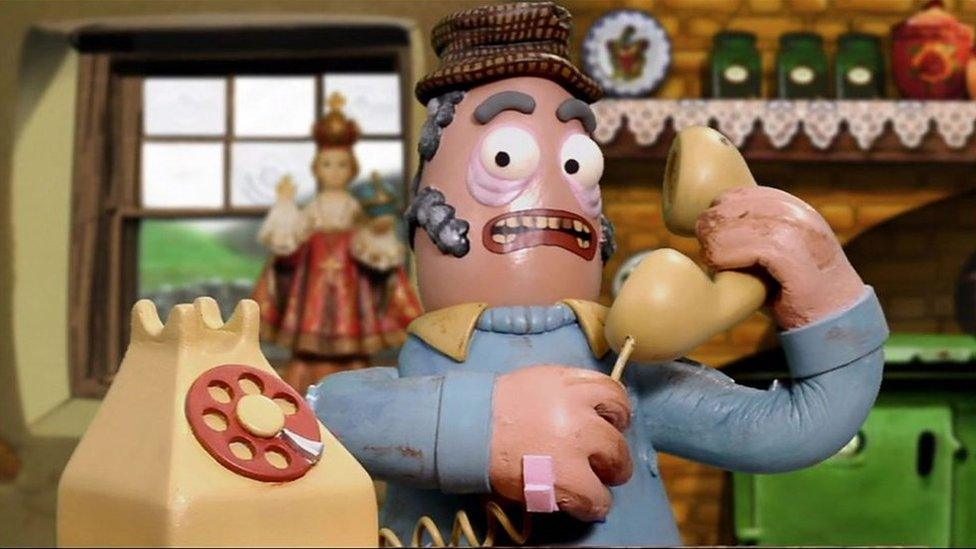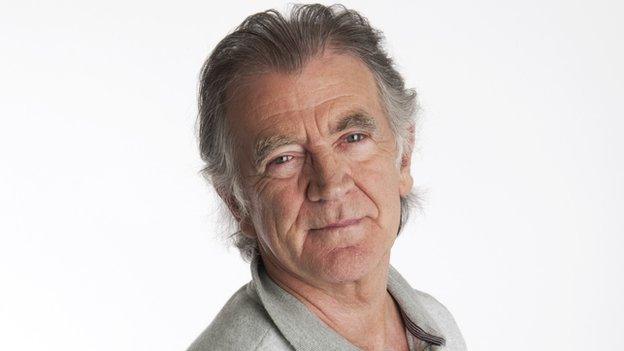Gerry Anderson and the tale of the hypnotised hen
- Published

The BBC Northern Ireland series On the Air showcased extracts from Gerry Anderson's funniest radio phone-in programmes
Ask anybody who knew him and they will tell you there was nobody like Gerry Anderson for "turning a conversation into a carry-on".
Now eight years after his death, the BBC Radio Ulster broadcaster's unique style is being appreciated by a whole new audience.
A clip from one of his radio programmes - featuring a hypnotised hen - has resurfaced and gone viral on Twitter, picking up more than two million views.
It was taken from a 2011 episode of the series On The Air, in which real-life audio from Gerry's weekday radio show was set to animation.
Allow X content?
This article contains content provided by X. We ask for your permission before anything is loaded, as they may be using cookies and other technologies. You may want to read X’s cookie policy, external and privacy policy, external before accepting. To view this content choose ‘accept and continue’.
The man who owned the hypnotised hen has now revealed the background to the incredible call and spoken of his fondness for Gerry.
"A friend of mine used to say: 'If there was a spark Gerry would be fanning it until it turned into a fire,'" said Pat Fairon from County Armagh.
'A backup squawk'
Pat had phoned the Gerry Anderson Show after hearing, on the previous day's programme, about a man who had a way of placing hens under hypnosis.
He had given it a go on one of his birds, which, he tells Gerry, "hasn't moved since".
The broadcaster then coaxes and coaches Pat as he revives the bird from its hypnotised state.
Mayhem ensues as a Child of Prague statue is broken and the bird escapes through a window.

Pat Fairon isn't convinced he looks like his on-screen representation
Speaking to BBC Radio Foyle on Wednesday, Pat said previous experience had taught him to be prepared for every eventuality.
"I have a confession to make here," he said.
"I had worked with Gerry before, on a previous occasion, getting a parrot to talk - they are notorious for shutting up when a microphone appears and I was worried."
So he prepared a "backup squawk".
"I rigged up a cackle," he explained.
"You take a paper cup, pierce a hole in it, run a bit string through it, so it's like a tail hanging out the end of the cup, and if you have rosin, like you put on a violin bow, you rub that on the string to give it a wee bit of friction.
"And when you pluck, run your hand down it - it makes the most effective chicken squawk you ever heard."

Gerry Anderson was inducted into the UK Radio Hall of Fame in 2005
But Pat didn't need it and what is heard is genuine, he said.
"The chicken was there but I wasn't sure she was going to come out [of the 'hypnosis'] alright.
"Little did I know what she was going to do when she did come out.
"She needed no help in letting the world know she was free and ready to fly."
The bird, he added, "was a loved hen who continued to be loved" and was not harmed in any way.
'Ahead of his time'
Gerry started working as a radio presenter in 1984 and went on to become a household name in Northern Ireland.
The animated On The Air series, made by Belfast-based animation company Flickerpix, gave a fresh perspective on the quirky phone calls he took from listeners on his radio programme.
The hypnotised hen clip was given new life after it was tweeted by journalist Paul O'Kane on 21 September, external.
Broadcaster Lorraine Kelly and Derry Girls creator Lisa McGee are among those who have shared it since then.

Gerry Anderson formed a successful on-air partnership with fellow broadcaster, Séan Coyle (left)
Gerry's unique broadcasting style is undoubtedly key to its renewed success, Pat said.
"Conversation takes off and turns into a carry on and everyone is involved and feeding into it and building the craic - essentially that was the secret, what made Gerry as good and as great as he was," said Pat.
David Anderson, the late broadcaster's son, said the success the clip has had since it re-emerged online had been incredible.
He said his father "probably would have said: 'I'm not surprised - sure it's funny, isn't it?'"
"He was deadpan and warm and he knew he was ahead of his time," added David.
"It was always about the work, making sure the work was funny and that people enjoyed it.
"To see that coming through, I am delighted, it is fantastic."
- Published21 August 2014

- Published21 August 2014